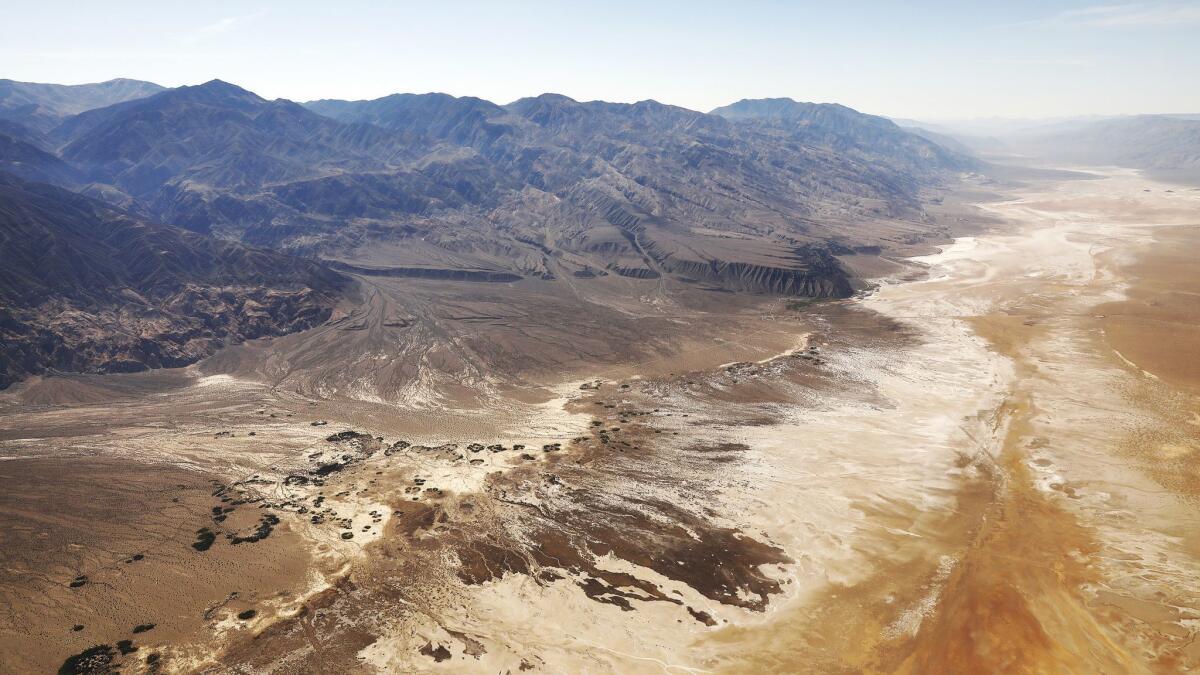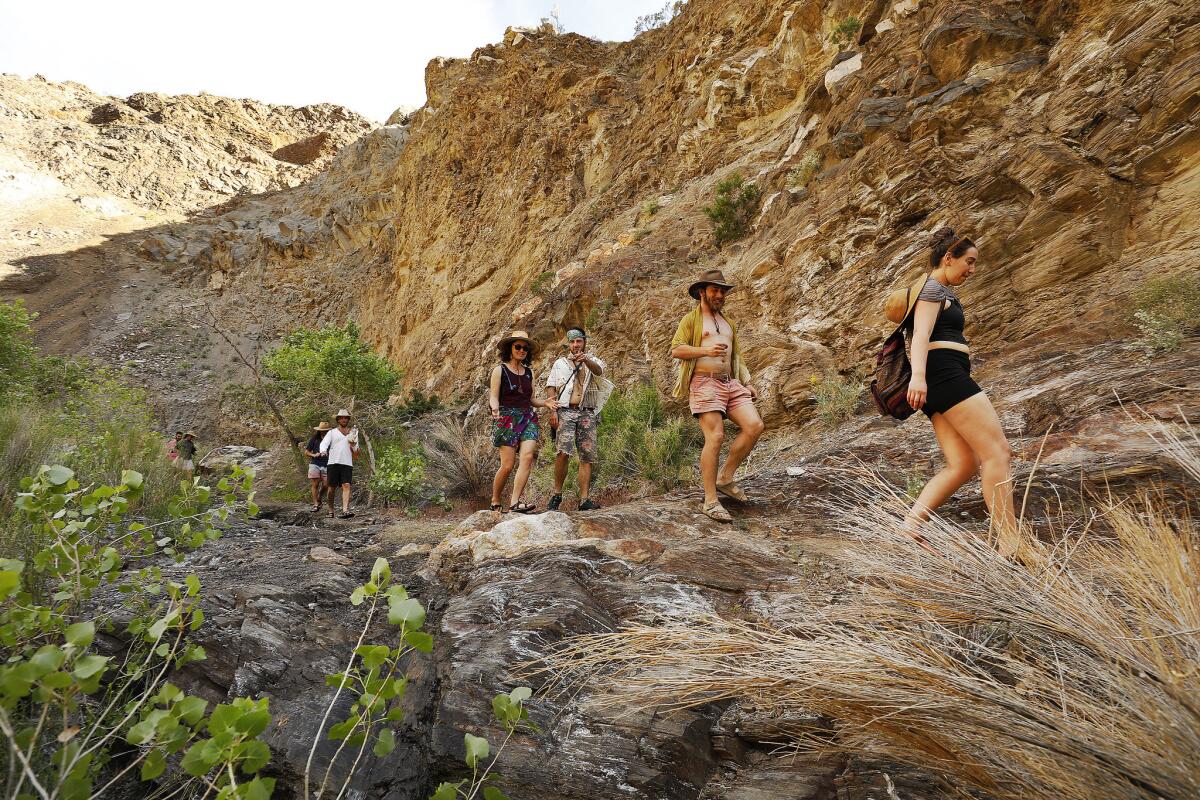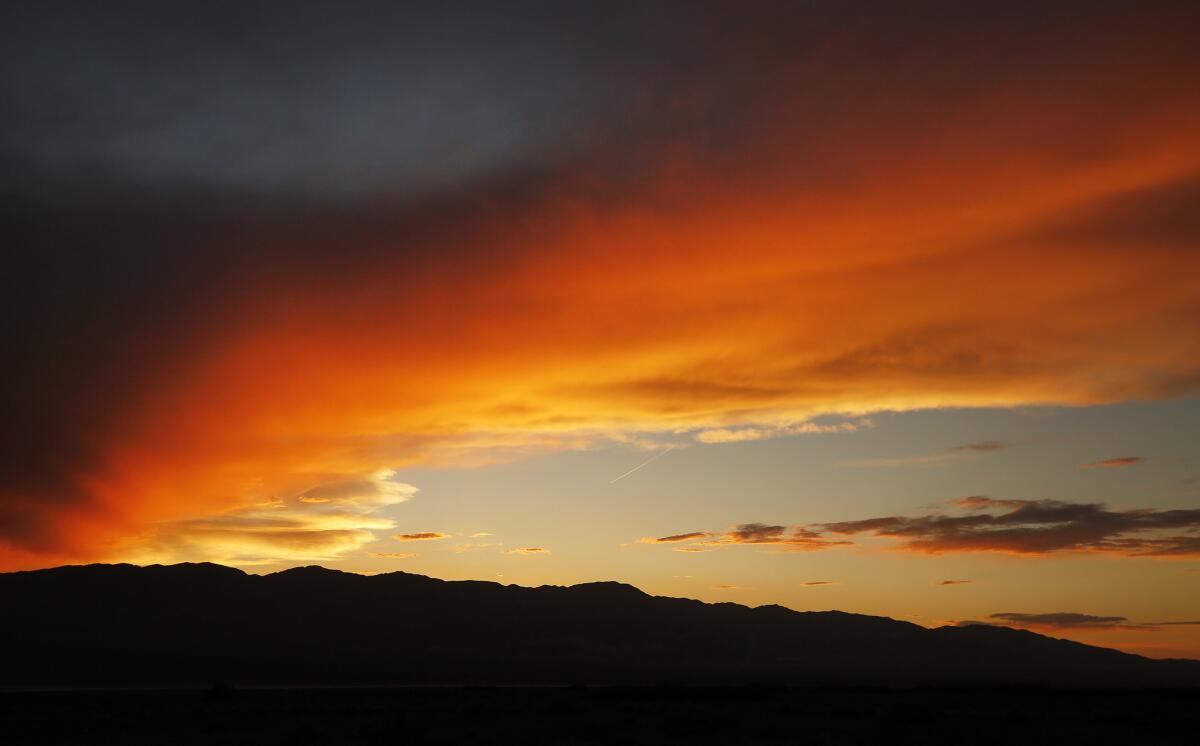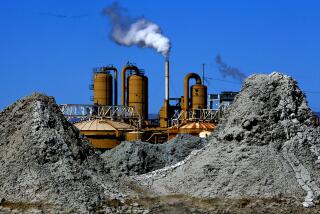Must Reads: A war is brewing over lithium mining at the edge of Death Valley

A request to drill for lithium near Death Valley National Park has alarmed environmentalists, who say mining the metal is unacceptable, even if it is an essential ingredient in the production of zero-emission electric vehicles.
Reporting from Panamint Springs, Calif. — A small Cessna soared high above the Mojave Desert recently, its engine growling in the choppy morning air. As the aircraft skirted the mountains on the edge of Death Valley National Park, a clutch of passengers and environmentalists peered intently at a broiling salt flat thousands of feet below.
The desolate beauty of the Panamint Valley has long drawn all manner of naturalists, adventurers and social outcasts — including Charles Manson — off-road vehicle riders and top gun fighter pilots who blast overhead in simulated dogfights.
Now this prehistoric lake bed is shaping up to be an unlikely battleground between environmentalists and battery technologists who believe the area might hold the key to a carbon-free future.
Recently, the Australia-based firm Battery Mineral Resources Ltd. asked the federal government for permission to drill four exploratory wells to see if the hot, salty brine beneath the valley floor contains economically viable concentrations of lithium. The soft, silvery-white metal is a key component of rechargeable lithium-ion batteries and is crucial to the production of electric and hybrid vehicles.

The drilling request has generated strong opposition from the Center for Biological Diversity, the Sierra Club and the Defenders of Wildlife, who say the drilling project would be an initial step toward the creation of a full-scale lithium mining operation. They say lithium extraction would bring industrial sprawl, large and unsightly drying ponds and threaten a fragile ecosystem that supports Nelson’s bighorn sheep, desert tortoises and the Panamint alligator lizard, among other species.
“A lithium mine would destroy these spectacular panoramas,” drilling opponent Tom Budlong said recently as he and fellow activists buzzed over the Panamint Valley in a chartered Ecoflight aircraft.
The battle could be a fierce one. Lithium is expected to play an increasingly important role in reducing greenhouse gas emissions from cars and trucks, and has been designated by the Trump administration as a mineral essential to the economic and national security of the United States. In addition to powering countless laptops and cellphones, lithium-ion batteries may also play a role in guarding against power line wildfire ignitions.
The only functioning lithium mine in North America is about 150 miles away in Clayton Valley, Nev. Most of the lithium used for batteries now comes from the so-called Lithium Triangle of South America — a region that includes the world’s largest salt flats.
For dyed-in-the-wool environmentalists, the brewing war over lithium mining poses a moral dilemma as it seemingly pits them against efforts to reduce greenhouse gas emissions.
Constructed with the world’s lightest metal, rechargeable lithium-ion batteries allow vehicles to run on power generated by wind turbines, solar panels, hydroelectric dams and other clean-energy sources. In California alone, officials hope to see as many as 5 million such zero-emission vehicles on state highways by 2030.
Drilling opponents also acknowledge that the burden of producing lithium should not just fall on nations with less restrictive health and safety regulations and environmental safeguards.
“It’s a tricky question,” said Lisa Belenky, senior attorney at the Center for Biological Diversity. “We shouldn’t export the sacrifices to Bolivia and Argentina, for example, which have massive lithium mines. … We also think that Panamint Valley is not the right place for it.”

The Inyo County drilling sites are overseen by the U.S. Bureau of Land Management, which, under federal law, is obligated to not only preserve public lands, but make them productive as well. The BLM must set aside some lands for mining and wilderness, for wildlife and off-road vehicle riders alike.
But environmentalists say the agency is tilting too far toward the needs of commercial interests and away from the long-term health of the public’s natural resources. They worry approval of the plan could trigger a “white gold rush” across the deserts of Southern California. Already, nearly 2,000 lithium claims have been staked across 30,000 acres of public land administered by the BLM in California.
In a formal response to the drilling proposal, a dozen environmental organizations expressed concerns about the effects on ground and surface water if exploration leads to an industrial-scale mine.
The environmental assessment “does not include mapping of floodplain boundaries, nor any hydrologic modeling or analysis,” the response read. “There is no discussion of the risks to cross contamination from the deep brines to the freshwater aquifer, and the drill site reclamation practices do not appear to have taken this risk into account.”
Among those who have spoken against the plan are officials at Death Valley National Park.
A large mining operation would have “significant water requirements,” Death Valley National Park Supt. Mike Reynolds wrote in comments filed with the BLM. Reynolds said water in the area flowed downhill from the park to the mine sites on the valley floor. “This water would normally help support wildlife within the local ecosystem,” he wrote.
The U.S. Bureau of Land Management is expected to make a final decision on Battery Mineral Resources’ request later this year.
Battery Mineral Resources failed to respond to repeated requests for comment on the proposal. However, an environmental assessment of its exploratory project concluded it would be safe, prevent significant environmental harm and abide by state and federal regulations.
As of April, the company reported anticipated costs of more than $7 million for exploration, claim maintenance fees and payments to a geology consultant in Arroyo Grande.
The Panamint Valley shares many of the geological features seen in profitable lithium-brine deposits in Chile, Argentina, Bolivia and Nevada: arid climate, an active fault, a basin encircled by rock mountains, and underground brine pools heated by geothermal activity.
Lithium brine deposits account for the majority of world’s lithium production. The process involves pumping water from aquifers and placing it in a succession of large evaporation pools. Over time, the lithium becomes more and more concentrated and can be separated from the water and processed.
In addition to Panamint Valley, lithium mining claims have been staked in portions of the Amargosa Basin near Beatty, Nev., which includes stretches of the Amargosa River, which was listed earlier this year as a National Wild and Scenic River.
Although environmentalists fear a run on lithium, one expert said it was no simple task to open a mining operation. A years-long effort to establish one at Imperial County’s Salton Sea has yet to bear fruit.
“On the face of it, extracting lithium from brine seems simple — pump it out of the ground, and then divert it into evaporation ponds that leave behind heaps of dried product ready for shipping,” said Brian Jaskula, a U.S. Geological Survey expert on mining.
Although lithium-ion batteries currently dominate the electric vehicle market, they face competition from an array of new, more affordable and environmentally safe technologies in development, said Parans Paranthaman, group leader of the chemical sciences division at Oak Ridge National Laboratory in Oak Ridge, Tenn.
“Lithium-ion batteries, which were developed in 1991, are the most viable in the near term,” he said. “But beyond lithium, there will soon be zinc, sodium, magnesium and potassium batteries, among others.”
Dr. Patrick Soon-Shiong, the owner of the Los Angeles Times, is also the chairman of NantEnergy, an El Segundo-based firm that has developed a rechargeable zinc-air battery, as well as a hybrid zinc-air and lithium-ion battery. The batteries are used primarily in microgrids and communication facilities.

On a recent weekday in Panamint Valley, sentiment was split over the prospect of a lithium mining operation in this sparsely populated area of Inyo County.
Rock Novak, 65, the caretaker of a trading post in the strike-it-rich ghost town of Ballarat, was telling anyone who would listen that environmental protections are unwanted encroachments on the region’s enjoyment of unshackled freedom from everyday rules and regimens.
Sitting back in a chair on a wooden porch and gazing out at salt flats that host a frenzy of high-speed off-roaders, Novak said, “I’d rather see this desert torn up by mining than be under the dictatorship of the National Park Service.”
Not far away, in Surprise Canyon, hikers wandered a trail that followed a perennial, spring-fed stream fringed with cottonwood trees and wild orchids that earlier this year was designated a National Wild and Scenic River. Most of the hikers were part of a Wilderness Torah outdoor camping event held to celebrate Judaism’s spiritual connections with nature.
Another hiker was David Lamfrom, director of California and Desert programs for the National Parks Conservation Assn., who wondered whether the charms of Surprise Canyon — silence, solitude and natural beauty — could survive in the face of pumping systems, evaporation ponds and heavy equipment spread across thousands of acres.
“This is a misplaced mining project in an area that the public has already agreed should be protected for generations to come,” Lamfrom said. “It makes no sense to turn our backs on those promises.”

L.A. Times Today airs Monday through Friday at 7 p.m. and 10 p.m. on Spectrum News 1.
More to Read
Sign up for Essential California
The most important California stories and recommendations in your inbox every morning.
You may occasionally receive promotional content from the Los Angeles Times.











